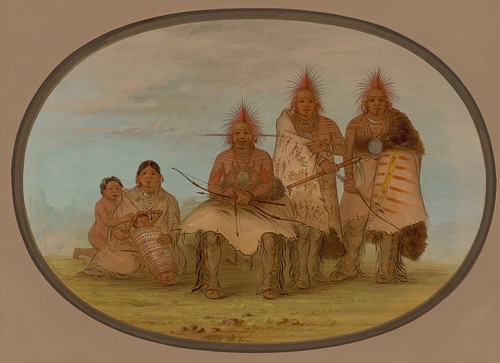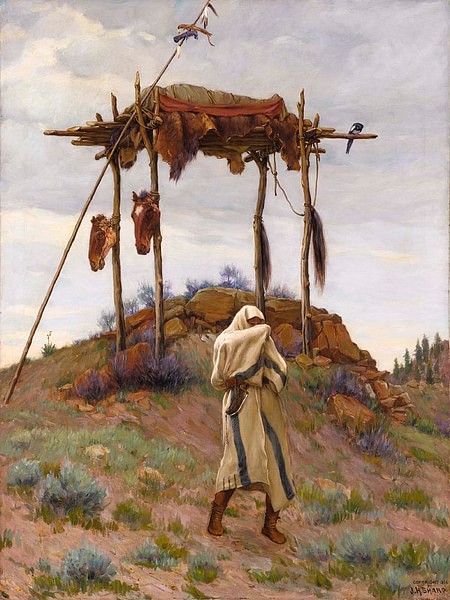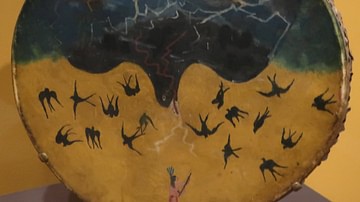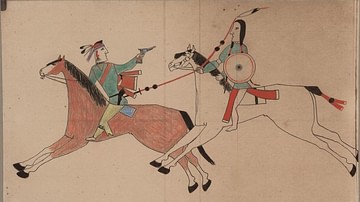The Ghost Bride is a story from the Pawnee nation on the danger of interacting with ghosts but also emphasizes the importance of keeping one's word, whether with the living or the dead. The young man in the tale does not know he is dealing with a spirit, and this ultimately costs him dearly.
The story shares similarities in theme and detail with the more popular Pawnee tale, The Ghost Wife, in which a widower convinces the spirit of his late wife to leave the land of the dead and return with him and their child to the village. In that story, the widower is ultimately to blame for his fate and his child's because of his refusal to accept his loss as a natural aspect of the human condition and his insistence on having things his way.
In The Ghost Bride, the young man who encounters the spirit is also finally responsible for what happens to him, but in this case, he has no idea he is dealing with a ghost. As far as he knows, the woman he finds in the abandoned village is his fiancé, and he believes the reason she gives for being there alone. The audience of the story knows she is a ghost, however, and the original hearers of the tale would have understood it as a warning against ignoring what one knows in believing whatever one chooses to. The young man knows his fiancé should have been with the rest of the tribe but accepts her reason for being alone because it suits his desires.
The Ghost Bride and The Ghost Wife include the same detail of a revenant requiring four days hidden behind a curtain before they can rejoin the living and a conclusion relating to belief in the afterlife. Both stories also feature a female spirit who is faithful to a man who seems unworthy of her as he fails to either honor or acknowledge the traditions of the community. The Ghost Bride differs significantly from the other story, however, in highlighting the weight of one's word, the danger in failing to keep it, and how a ghost will always have the last one.
Ghosts & Origin of Story
Generally speaking, the Native peoples of North America understood ghosts as a fact of life but, in most instances, as entities to be avoided, not trusted. The medicine bag one would carry – a bundle of magical items of spiritual power – would usually contain some item or items that protected one from ghosts and evil spirits. Still, there were times when one could not help but encounter a spirit, and once engaged, it was important to remember that ghosts possessed supernatural knowledge and power and should be treated with respect.
One of the best examples of this is the Teton Sioux story, The Man Who Wrestled with a Ghost, in which a young warrior encounters a ghost in the woods, shares tobacco and food with him, and is rewarded with a prophecy of success concerning his mission against his enemies. That story ends with the young warrior succeeding "just as the ghost said. That is why people believe what ghosts say" (Jackson, 335). Since ghosts came from the spirit world, where the secrets of life, death, past, and future were all known, their words could, under the right circumstances, be trusted, but under other conditions, a ghost might relay some information the living had no right to, or lure the living down a wrong path, and so bring on disaster or death.
In The Ghost Bride, the spirit deliberately misleads the young man but keeps her promise that they will soon be married, merging the traditional understanding of ghosts as dangerous threats and truth-tellers. The story initially presents the female spirit as a deceiver and later as an innocent who only wants to live again among her people and marry the man she loves.
The date of composition of the tale is unknown, but it originates, in its present form, in Pawnee Hero Stories and Folk-Tales (1889) by the anthropologist and historian George Bird Grinnell (l. 1849-1938). Grinnell lived and traveled with the Pawnee beginning in 1870 and recorded their traditions and stories in articles and longer works. In his introduction to the 1889 book, he explains his method of preserving stories like The Ghost Bride:
The task that I have set for myself is that of a recorder. No attempt has been made to give a literary color to the hero stories and folk-tales here written out. I have scrupulously avoided putting into them anything of my own. The stories are told to the reader as they were told to me. They are not elaborated. I have tried to show how Indians think and speak, rather than to make their stories more entertaining by dressing them up to suit the civilized taste. My object in giving these narratives their present shape is to make a book which shall be true to life and shall faithfully reflect the Pawnee character, as the story tellers have themselves painted it. In a very few cases, I have added some words explaining matters so well understood by those familiar with the Indians as to need no explanation. If these tales have any ethnological value, it will be enhanced by their being given in the precise form in which they were told by those to whom they have been handed down from generation to generation. (xii)
The Ghost Bride, then, may be hundreds or thousands of years old, and at the time in which Grinnell lived among the Pawnee, it was one of the many regularly performed by storytellers.
Text
The following text is taken from Pawnee Hero Stories and Folk-Tales by George Bird Grinnell, 1889, pp. 191-194.
In a place where we used to have a village, a young woman died just before the tribe started on the hunt. When she died, they dressed her up in her finest clothes and buried her and, soon after this, the tribe started on the hunt.
A party of young men had gone off to visit another tribe, and they did not get back until after this girl had died and the tribe had left the village. Most of this party did not go back to the village but met the tribe and went with them on the hunt. Among the young men who had been away was one who had loved this girl who had died. He went back alone to the village.
It was empty and silent but, before he reached it, he could see, far off, someone sitting on top of a lodge. When he came near, he saw that it was the girl he loved. He did not know that she had died, and he wondered to see her there alone, for the time was coming when he would be her husband and she his wife [and she should have been with the rest of the tribe where she would be safe].
When she saw him coming, she came down from the top of the lodge and went inside. When he came close to her, he spoke and said, "Why are you here alone in the village?" She answered him, "They have gone off on the hunt. I was sulky with my relations, and they went off and left me behind." The man wanted her now to be his wife, but the girl said to him, "No, not yet, but later we will be married." She said to him, "You must not be afraid. Tonight, there will be dances here; the ghosts will dance."
This is an old custom of the Pawnee. When they danced, they used to go from one lodge to another, singing, dancing, and hallooing. So now, when the tribe had gone and the village was deserted, the ghosts did this.
He could hear them coming along the empty streets and going from one lodge to another. They came into the lodge where he was and danced about, and whooped and sang, and sometimes they almost touched him, and he came pretty near to being scared.
The next day, the young man persuaded the girl to go on with him, and follow the tribe, to join it on the hunt. They started to travel together, and she promised him that she would surely be his wife, but not until the time came. They overtook the tribe but, before they got to the camp, the girl stopped.
She said, "Now we have arrived – but you must go first to the village and prepare a place for me. Where I sleep, let it be behind a curtain. For four days and four nights I must remain behind this curtain. Do not speak of me. Do not mention my name to anyone."
The young man left her there and went into the camp. When he got to his lodge, he told a woman, one of his relations, to go out to a certain place and bring in a woman who was waiting there for him. His relative asked him, "Who is the woman?" And, to avoid speaking her name, he told who her father and mother were. His relation, in surprise, said, "It cannot be that girl – for she died some days before we started on the hunt."
When the woman went to look for the girl, she could not find her. The girl had disappeared. The young man had disobeyed her and had told who she was. She had told him that she must stay behind a curtain for four days and that no one must know who she was. Instead of doing what she had said, he told who she was, and the girl disappeared because she was a ghost. If he had obeyed the girl, she would have lived a second time upon the earth.
That same night, this young man died in his sleep.
Then the people were convinced that there must be a life after this one.
Commentary
In The Ghost Wife, the spirit of the wife is given a second life after she agrees to follow her grieving husband back to the village and only vanishes when confronted by his second wife, who points out she is a ghost and does not belong among the living. The husband, though responsible for bringing her back, does nothing to make her leave. In The Ghost Bride, however, the young man disappoints his fiancé's hope for a second life by failing to do as she asked and not keeping his word. Although the story never explicitly states his promise, the unspoken word would have been understood by the original audience as having been given.
The young man has no idea he is interacting with a spirit and so, when he fails to honor her request, he is disrespecting a woman he intends to marry, which, in Pawnee culture, would have also meant disrespecting her family, his family, and himself. He could have easily told his relative in the village that he had promised not to speak the woman's name and then asked her not to press the issue. Instead, he speaks the names of his fiancé's parents, breaking his promise and condemning himself to death because, even though his promise turns out to be false, the ghost's promise that they will soon be married holds true – just as the words of all ghosts were understood as true – and so they are married, not in this life, but in the one that comes after.
The power of the story develops through the tension of what the audience knows from the beginning and what the young man believes he is experiencing throughout, and further, from what the original audience would have recognized as serious breaches in custom and what the young man finds acceptable even though he should know better, considering his age.
When he first finds his fiancé alone in a deserted village, he should have realized she was not what she appeared to be, as even if she had argued with her relations, they would not have left her behind. In a famous story of the Sioux, The Legend of Standing Rock, a woman who refuses to move on when the rest of the community does is left where she sits, but later, her husband sends his people back to retrieve her. In this same way, the Pawnee village would have sent someone back for this woman.
After ignoring that, the young man then stays in the lodge after he is told by the spirit that the ghosts will be arriving soon to dance. Since ghosts were to be avoided, and since she so easily tells him not to be afraid of their arrival, he should have recognized her as one of them. After both experiences, however, the young man continues to believe the woman is who she appears to be instead of what the audience knows she is. For those hearing the tale told long ago, the experience of the story would most likely have been comparable to watching a modern-day horror movie where one keeps yelling at the main character, "How are you not seeing this?"
Conclusion
This story, and many others – not only of the Pawnee but of other nations such as the Cheyenne – were recorded by Grinnell and others to preserve them. By the 1880s, the Plains Indians nations had either already been forced onto reservations or soon would be, including the Pawnee, and there were some among the white immigrants who recognized the value of the Native American cultures that were being systematically eliminated. Grinnell, in explaining his motivation for writing Pawnee Hero Stories and Folk-Tales, notes:
The Pawnee are passing away. When I first joined them on their buffalo hunts [c. 1870] from their old home on the Loup Fork in Nebraska, the tribe numbered three thousand; last March [c. 1889] in the Indian Territory [the reservation they were relocated to in modern-day Oklahoma], I found but eight hundred. And more rapidly than the dwindling of the people are their traditions lapsing from memory under the changed conditions of the tribe's life. The lore, which sprang up as an indigenous growth of the wide-stretching prairie and the wilderness where the wild Pawnee warrior hunted free, finds scanty nurture in the uncongenial soil of fields tilled by Pawnee followers of the plow. With the new modes of living come new views of life, new motives, new sympathies – in a word, civilization. (xi)
The Pawnee, however, did not pass away. As they had always been regarded as "friendly Indians" by the US Government, they were afforded considerations not given to other nations, such as the right to observe The Ghost Dance ritual which, among its other aspects, highlighted the importance of the peoples' past, including the stories that preserved their cultural heritage. Today, the Pawnee still tell these same stories, teaching them to their children in their own language, and passing them on to future generations.








